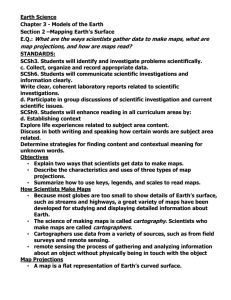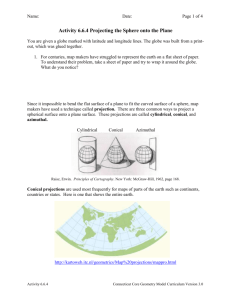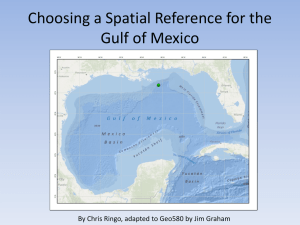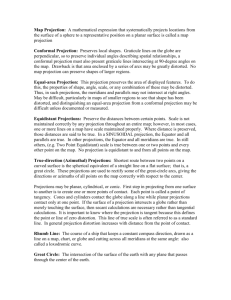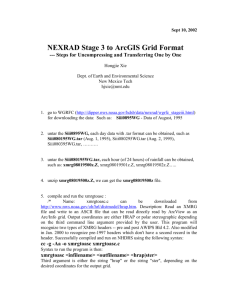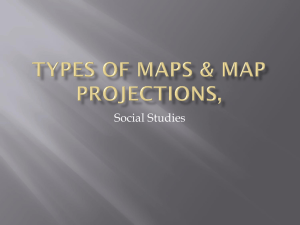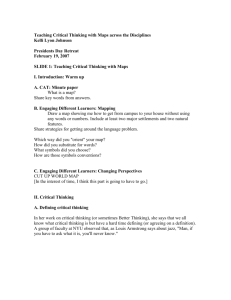Lecture 5 - Projections for the World
advertisement
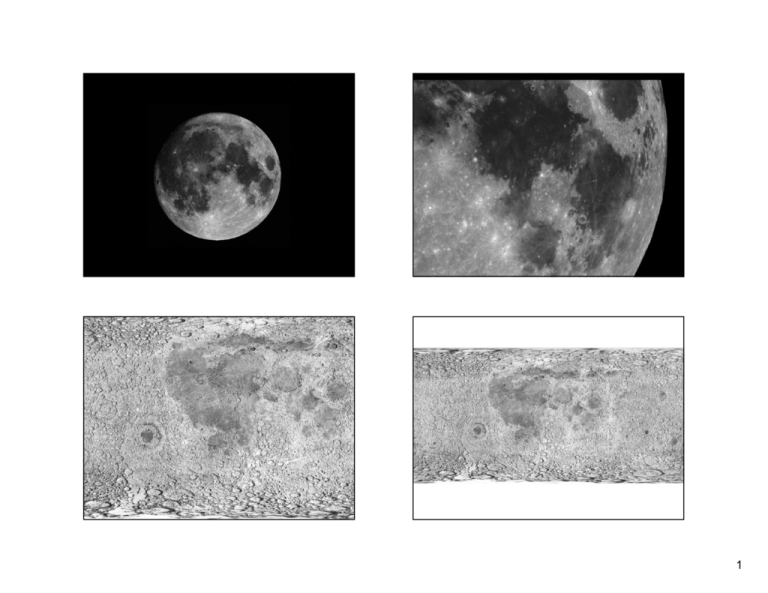
1 Map Projections (Part 1) Three classes (families) of projections: Developable surface as a: Earth is a round, maps are not. • Planar (Azimuthal), project the globe onto a tangent plane. Four projection families. • Conic, project the globe on to a cone Equivalent (Equal Area) projections Preserves relative areas Commonly used for thematic maps Ex: Albers • Cylindrical, central cylindrical vs. cylindrical equal-area Conformal projections Preserve angles, correct shape … with small shapes at least Graticule has right angles Ex. Mercator Equidistant Preserves distance, equal scale along standard parallel(s), latitude of origin * No flat map is both equivalent and conformal – only globes have this property cylindrical planar conical (not comical) Perspective (“point of projection”) Orthographic - light source at infinity (straight through) Stereographic Stereographic - light source at opposite side of the sphere Gnomonic - centrally located light source - preserves great circles as straight lines - distortions increase from standard point or line, increase outward in concentric bands Gnomonic Orthographic The transformation process simplified: a light source is in center of the cut out globe casts shadows from the continents of the model of the Earth onto on a plane that is tangent to it, tracing the outline leaves projected coordinate system. 2 Azimuthal (planar) class – developable surface is a plane Lambert Azimuthal Equal-Area Two cases Stereographic “perspective” It has both classes of map projection: Secant case Azimuthal: preserves directions from the tangent point scale compression Tangent plane, headings correct from central point Equal-area: lowest scale distortion of all azimuthal projections Circles same size Stereographic “perspective” Stereographic Projection (perspective) Azimuthal Conformal Circles same size Used in geophysics and orbit trajectory solutions, simplifies for solving spherical geometric problems Stereographic Polar Stereographic Equatorial Stereographic Oblique Stereographic 3 Orthographic Projection (perspective) Azimuthal non-Conformal Circles different size vs. Oblique Orthographic Popular visualization, the “earth from space” perspective view Right, Caption read something like: “The Senator is using tax payers dollars to make an out of the way illegal campaign stop to Anchorage” Distortion is extreme Polar Orthographic Mercator Projection Equatorial Orthographic Oblique Orthographic Dashed = rhumb line (constant heading) Solid = great circle route A line that crosses all meridians at the same angle is called a rhumb line, loxodrome, (or azimuth) Gnomonic Projection (perspective) Distorts everything – but straight lines are great circles Gnomic projections are in the planar family, used in aviation because great circles are straight lines Useful for finding the shortest path distance between two locations, but limited because < ½ hemisphere is visible Polar Gnomonic Equatorial Gnomonic Oblique Gnomonic Mercator 4 Conic class (family) – developable surface is a cone Lambert Conic Conformal Secant case (two tangent lines) Standard parallels 30n 45n Secant case scale compression Tangent line(s), where distortion is minimized Cylindrical class (family) – developable surface is a tube Conic Equal-Area Lambert (tangent) Secant case scale compression Tangent line(s), where distortion is minimized Albers (secant) 5 Plate Carree = Geographic Equirectangular (“Rectangular”) Equidistant Cylindrical Equidistant Cylindrical Based on Earth as a sphere, tangent along Eq. A form of the Geographic projection; the difference is that there are two standard parallels, 30 N and 30 S (secant) Distorts shape and area, but preserves distance Parallels lines have wider spacing than meridians (compresses the map in the east-west direction) *non-existent Figure 8.5 in Slocum 30 degree graticule Lambert Cylindrical Equal-Area Mercator Preserves area but distorts shape (tangent at Eq., shape distortion minimized there) Cylindrical Conformal The only projection that preserves bearings, rhumb lines (loxodromes) are straight lines - intersect meridians at the same angle Area/Shape are distorted, goes to infinity at the poles 6 Propaganda Map World Communism Today Transverse Mercator Cylindrical Equal-Area Oblique Mercator Cylindrical Equal-Area Mercator projection distorts area “Maps and Perceptions of Scale” Lanegram and Palm eds. 1973 From Map Misuse Campbell Ch 16 Sinusoidal Werner Pseudo-cylindrical Equal-area Pseudoconic, Equal-area Equally spaced parallels Cordiform (heart shaped) Projections: http://www.3dsoftware.com/Cartography/USGS/MapProjections/ 7 Equal-area conic (Albers Lambert Conic, popular projections) Equidistant projections Projection onto a cone, secant means there are two standard parallels From a point, distance is correct to all other points. Distortions increase away from standard parallels which can be varied to preserve area, angle, distance, or direction Equal-area = equivalent, preserves area relationships, best for thematic mapping where accurate area statistics are of importance Useful for plotting the distance for surface routes from a point, distortion increases outward * Distance and area are distorted * Distance distortion = give up shape (conformality) to preserve area (equivalence) Azimuthal projections Tangent at one point, directions are correct from that center-point to other points Distances are correct along parallels * Shape and area are distorted equivalent not equivalent Conformal maps Sinusoidal Angular relationships preserved between points (shape preserved for small areas), scale change uniformly with direction Classification: Pseudocylindrical, Equal-area (equivalent) If the scale of a map at any point is the same in any direction, the projection is conformal. Equally spaced parallels Meridians and parallels intersect at right angles. Arizona, New Mexico, Colorado and Utah on a globe meet at 90˚ angles, on a conformal projection map these angles are 90˚ angles * Area will be distorted 8 All projections distort Preserving area: equivalent, preserving angles/shape: conformal * cannot preserve both area & shape Preserving distance: equidistant * cannot preserve area & distance Preserving direction: azimuthal (plane) * can preserve direction and area, OR shape, OR distance Compromise projection don’t preserve area, shape, distance, or direction but minimize distortion overall (good for world maps for general use) Robinson, Miller, Gall-Peters etc. Robinson Arthur H. Robinson (Jan. 5, 1915 - Oct. 10, 2004) Pseudocylindrical University of Wisconsin emeritus professor of geography and cartography. Compromise: neither conformal nor equal area Created at the request of Rand McNally, the National Geographic Society, and others for numerous world maps. Uses tabular coordinates rather than mathematical formulas to make the world map “look” right. Robinson devised his own map projection after he became dissatisfied with existing projections is his experience as director of the map division of the Office of Strategic Services in World War II. "I started with a kind of artistic approach," Dr. Robinson said in a 1988 interview in The New York Times. "I visualized the best-looking shapes and sizes. I worked with the variables until it got to the point where, if I changed one of them, it didn't get any better.“ Only then, he said, did he "figure out the mathematical formula to produce that effect." For his projection, Dr. Robinson chose 38 degrees north and 38 degrees south as the standard parallels. This established the two places on the map where both size and shape are most accurate in the middle of the temperate zone, where most of the land and people are. The Robinson projection was eventually adopted by the National Geographic Society, some federal agencies and the world atlases of Rand McNally. http://www.nytimes.com/2004/11/15/obituaries/15robinson.html 9 Gall-Peters cylindrical equal-area projection (orthographic light source, perspective) De-emphasizes the exaggeration of areas (shape distortion) at high latitudes by shifting the standard to 45 degrees north Mercator Peters 10
